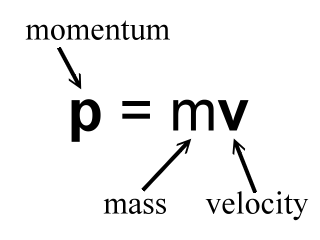Introductory Momentum Equations, Definition
![]() Basic definition:
Basic definition:
Momentum is equal to mass times velocity. It is symbolized with a small p. Mass is symbolized with a small m, velocity with a small v.
|
Momentum equals mass times velocity. |

Here is an example calculation. Notice that the unit for momentum is kg-m/s.

|
Line 1: Definition of momentum. Line 2: Enter example values for mass and velocity. Line 3: Calculate the resultant momentum. |
So an object with a mass of 3.0 kg that is traveling at a velocity of 4.0 m/s has a momentum of 12 kg-m/s.
Momentum is a vector. The size of this vector is equal to the value of the mass times the velocity. This size of the momentum is 12 kg-m/s in the above example. The direction of the momentum vector is the same as the direction of the velocity.
We can use algebra to rearrange the momentum equation. First we have:
p = mv (Momentum equals mass times velocity.)
Which rearranges to these equations:
m = p/v (Mass equals momentum divided by velocity.)
v = p/m (Velocity equals momentum divided by mass.)
Here are some small EZ Spread Sheets that calculate with the above momentum formulas:
p = mv
m = p/v
v = p/m
Check your understanding by trying some of these problems:
| Related Problems | |||
|